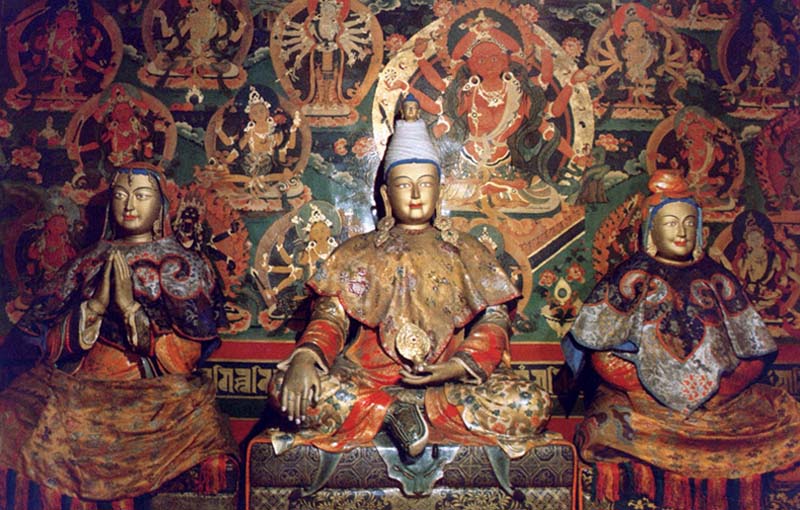Songtsen Gampo
The great Songtsen Gampo, King of all of Tibet, was determined to marry the daughter of the Emperor of China. Such a great match would be fitting for a ruler of his power and prestige. But T’ai-Tsung, the Chinese Emperor, was not sure he wished his daughter to be married to the King of Tibet. He did not have a very high opinion of the Tibetans. Besides, there were others seeking his daughter’s hand- Thokiki, the tartar ruler, for example. When Songtsen Gampo heard of this, he at once sent his armies against Thokiki and defeated him. Tibetan messengers again appeared at the Chinese court. Would the Emperor now agree to give away his daughter? A golden suit of armor was presented to T’ai-Tsung in an effort to persuade him. The Emperor, however, would not agree. He decided to fight the Tibetans instead.
This proved to be a mistake. The Chinese army was no match for the fierce Tibetan horsemen of Songtsen Gampo. The Chinese suffered a crushing defeat. T’ai-Tsung, however, still hoped to outwit the Tibetans. When the Tibetan envoys, led by Songtsen Gampo’s brilliant minister, Gar Tongtsen, arrived in the Chinese capital, the Emperor announced that there were other suitors for his daughter’s hand. Whoever passed four tests of wit and wisdom would win the princess. Gar Tsongtsen passed the first three tests with ease, but the last proved to be more difficult. He was required to select the princess, who he had never seen, from five hundred beautiful girls all dressed alike. The task seemed impossible. However, Gar Tsongtsen had one clue. He managed to find out that all the girls would be wearing fake flowers in their hair, but only the real princess would wear real ones. So when the girls were brought before him, he looked for the girl that the bees were attracted to, and so picked out the Emperor’s daughter. Songtsen Gampo had finally won his queen, the beautiful Wen-ch’eng Kung-chu.
Songtsen Gampo reigned for nineteen years from 630 AD to 649 AD. Tibetans especially love him for two main reasons. Firstly, he encouraged the growth of the Buddhist religion in Tibet. Secondly, his armies made Tibet into a mighty empire, feared and respected by all other peoples. As well as the Chinese princess, he also married a number of noble Tibetan ladies and the daughter of the King of Nepal, Princess Bhrikuti. Both of his foreign wives were devout Buddhists, and both built their own Buddhist temples in the center of Lhasa to house the many holy images they had brought with them.
During his reign, Songtsen Gampo’s armies repeatedly defeated the Chinese on the eastern border of Tibet. Tibetan forces also conquered parts of Burma, and occupied Nepal for a time. Some stories even tell of a Tibetan army marching into India, defeating the Indian Emperor, Arjuna.
But Songtsen Gampo was more than just a warrior. He was also an able ruler and a learned man. He moved his capital from Yarlung to Lhasa, and built a fort where the great Potala Palace stands today. On the advice of his minister, Gar Tsongtsen, the king appointed six governors to rule over his vast kingdom, and gave away land to his poorest subjects. But most importantly for Tibetan culture, he sent his minister, Thonmi Sambhota, and sixteen students to India to study. So unhealthy did the Tibetans find the climate of India, that all sixteen students died there. Only Thonmi Sambhota returned to Tibet. There he is said to have used his knowledge of Sanskrit and Kashmiri texts to invent the first Tibetan alphabet of thirty letters. He then began to work on translating Buddhist scriptures.
Today, however, there are many people who do not agree that Thonmi Sambhota created the very first Tibetan alphabet. They argue that there must have been a written Tibetan script before Buddhism arrived in Tibet. They point to the flourishing of the Yarlung kings, and argue that writing, which is the expression of a whole people’s culture, could never have been invented by one man, however exceptional. They believe that a simple script, called Ma-yig, based on writing used in Khotan, in eastern Turkestan, may have existed before the time of Songtsen Gampo.
Whatever the truth of this may be, it was the dedication and hard work of Thonmi Sambhota and his students that brought Buddhism and the first known written manuscripts to Tibet.


I would like to contact a Japanese Samurai
Hiroyuki Sanada
Japanese actor
for permission to hide the
Powers of the Queen of France and Austria
in Hong Kong
Book by Adeline Yen Mah
Falling Leaves: The Memoir of an Unwanted Chinese Daughter
Re: The Countess du Barry
My sister is the second wife
of the King of the United States
John Fitzgerald Kennedy II,
Sam Hunt, country singer
Jeannie Mai Jenkins (Lisa Jacobs)
continues to demand on television
that she is The Countess du Barry
My sister is Queen Elizabeth III
and she is hiding
By saying that she is The Countess du Barry,
Jeannie Mai Jenkins (Lisa Jacobs)
is claiming to be my sister
Queen Elizabeth III
right?
I would like to register these names
Antoinette Genai Herndon
Toni Seven
Antoinette du Dijon
Queen of France
Leigha Theresa Herndon
Adele Blue Adkins, UK singer
Queen Elizabeth III
Queen of The United Kingdom of Great Britain
Antoinette du Bordeaux
Countess du Bordeaux
Leigha Theresa Herndon
Queen Elizabeth III
is the
Countess du Bordeaux
There is
NO
Countess du Barry